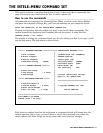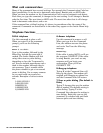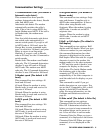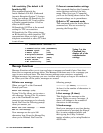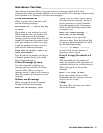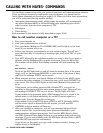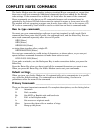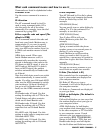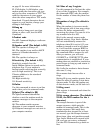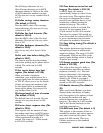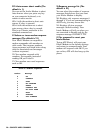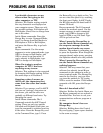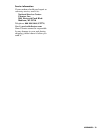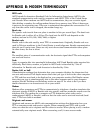
A–Answer a call
Use the answer command to answer a
call.
AT–Attention
The AT command issued by itself is
used to enter command mode. AT is
also the prefix for all of the other
commands. For example, issue the dial
command by typing ATD.
B–Use a specific code and speed (The
default is ATB0)
The B command controls the code and
baud rate your Intele–Modem uses to
communicate. If you want to specify
ASCII or Baudot code and the baud
rate, type ATB and a number from 0 to
4. What each number means is listed
below:
ATB0–Auto search. When your
Intele–Modem answers a call, it
automatically searches the incoming
signals to determine what code to use.
If it hears an ASCII signal, it stays in
ASCII code at 300 baud. If it doesn’t
hear an ASCII signal, the modem
switches automatically to Baudot code
at 45 baud.
Note that while Auto search can switch
codes automatically, it cannot switch
speeds. If a caller uses 110-baud ASCII
code, use the ATB4 command to switch
your modem to 110 baud. Similarly, if
you get a call in Baudot code at 50
baud, use the ATB2 command to match
speeds.
B1–Baudot code, 45 baud. Use this
setting for making calls to TTYs in the
United States and other countries
which use 45-baud Baudot code.
B2–Baudot code, 50 baud. Use this
setting for making calls to TTYs in
countries that use 50-baud Baudot
code.
B3–ASCII code, 300 baud. Use this
setting to make calls to computers and
300-baud ASCII TTYs.
B4–ASCII code, 110 baud. Use this
setting for making calls to 110-baud
ASCII TTYs.
D–Dial telephone
Type AT followed by D to dial a phone
number from your computer keyboard.
Press the Enter Key to dial. For
example:
ATD 5551212 [Enter]
You can specify tone or pulse dialing by
adding T or P to the command. For
example, to tone dial, use:
ATDT 5551212 [Enter]
Type P after ATD to tell your
Intele–Modem to pulse dial. For
example,
ATDP 5551212 [Enter]
Typing a comma within the phone
number causes a two-second pause in
dialing. If you’re using your
Intele–Modem in an office setting
where you need to dial 9 to get an
outside line, a pause may be needed to
allow time to get a dial tone. Here’s an
example:
ATD 9,5551212 [Enter]
You can use as many commas as you
need. Each one equals two seconds.
E–Echo (The default is E1)
Echo controls how the commands you
type to your modem are displayed on
your computer monitor.
E0–Echo off. When you type a
Command, it will not be displayed on
the computer monitor.
E1–Echo on. Commands are displayed
as you type them.
F–Full- or half-duplex (The default is
full-duplex)
Full-and half-duplex are two ways that
the modem displays what you type on
your computer screen.
ATF0–Half-duplex. In half-duplex,
your modem sends characters you type
to the other computer or TTY and also
to your computer screen. If each
character you type appears twice on
your monitor (HHII TTHHEERREE),
change to full-duplex. TTYs that use
Baudot code always use half-duplex.
See the Problem and Solutions section
COMPLETE HAYES COMMANDS • 17
What each command means and how to use it __________________
Commands are listed in alphabetical order.



